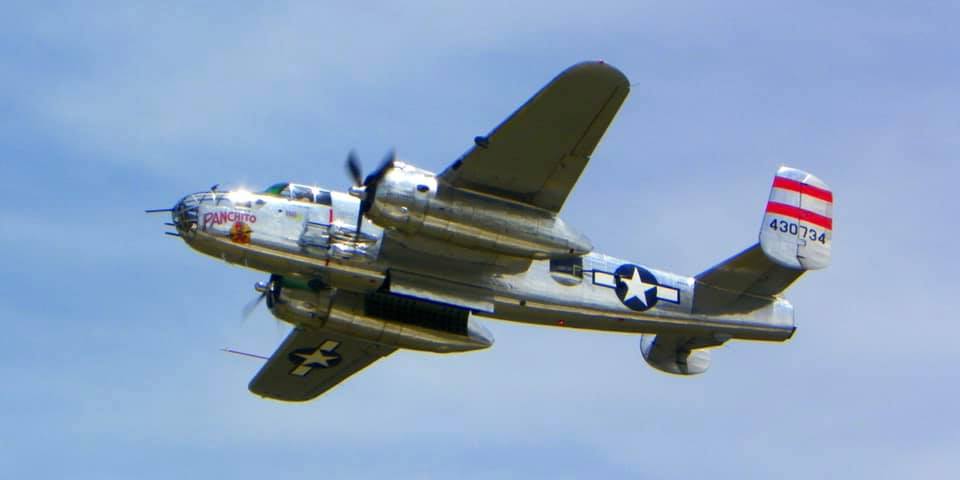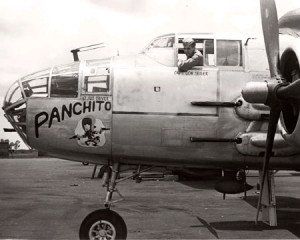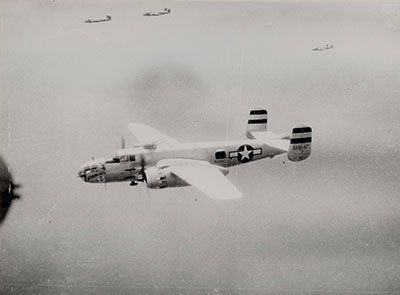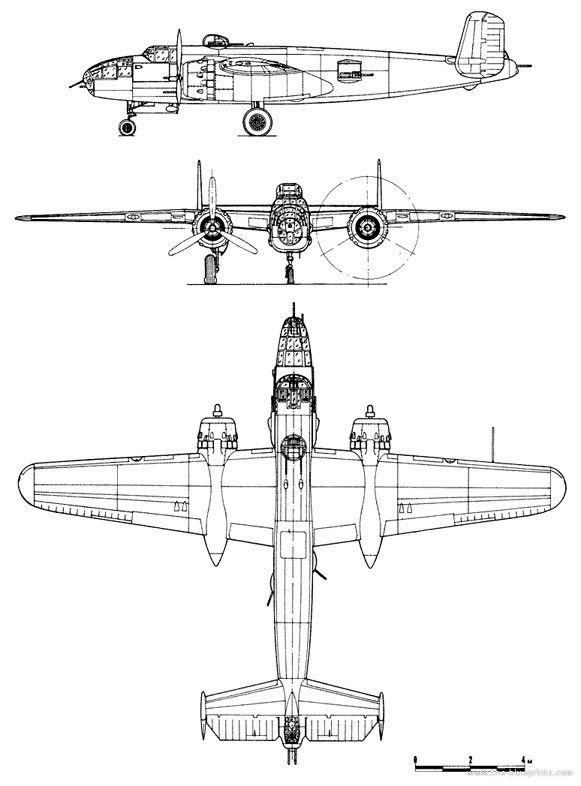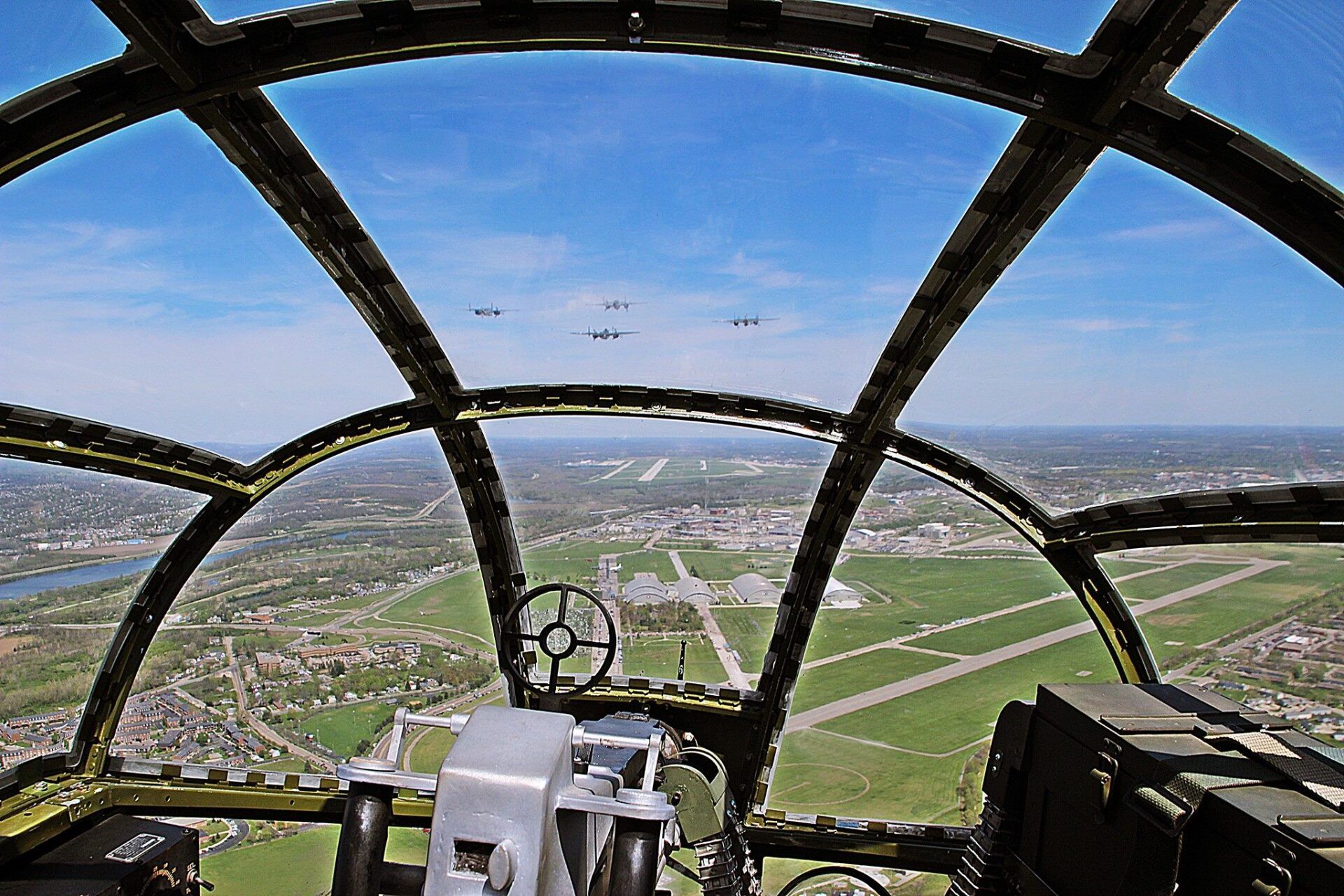B-25J Mitchell Bomber "Panchito"
Mention the B-25 or “Mitchell” to many people and they are likely to respond: “Oh, the Doolittle Raid”. While the attack on mainland Japan on April 18, 1942 was the most famous of its missions, North American Aviation’s magnificent medium bomber played a much larger part in World War II.
The B-25 was in production before the U.S. entry into the war through VJ-Day. About 9,815 B-25’s were built. This was the largest production of U.S. twin-engine combat airplanes in World War II. B-25’s were used in all theaters of war from Alaska to North Africa, China, Europe and the Southwest Pacific. They were flown by the U.S. Army Air Forces and U.S. Marine Corps, as well as the air forces of Britain, Canada, Australia, Russia, China, Brazil and the Netherland East Indies. Post war, B-25’s soldiered on in other roles as well as combat with the U.S. Air Force and the air forces of Canada, Indonesia and many Latin American countries.
The B-25 was designed as a medium bomber to operate at altitudes between 8,000 and 12,000 thousand feet. Powered by two 1700 hp Wright R-2600 engines, the basic configuration stayed the same throughout production. However, there were many changes in armament to improve both offensive and defensive capabilities. These variations included 75 mm cannon, rockets and up to eighteen .50 caliber machine guns. The armament modifications varied on the B-25’s depending on the squadron mission. Some B-25’s were modified to carry torpedoes; both standard aerial and glide versions. Tactics used in the South and Southwest Pacific included low altitude strikes with strafing and skip-bombing against shipping and para-frag bombs against airfield targets. The airplane was also used for photo-mapping, an advanced trainer and fast transport.
History Of The Original "Panchito"
The 41st Bombardment Group was the only B-25 medium bomber unit in the Seventh Air Force. The 41st operated in the Central Pacific Theater during the period from December, 1943 to October, 1944. The 41st flew over 240 missions in single squadron strength, often at low altitudes against Japanese shipping while bypassing many of the islands. On October, 1944, the 41st was transferred to Wheeler Field, Hawaii for rest, re-equipment, crew replacements and retraining.
The crew of the “Panchito” was composed of both combat veterans and recent trainee graduates. Pilot Capt. Don Seiler and bombardier Lt. Jud Driver, both seasoned combat veterans in their early twenties, were preparing for their second combat tour. Among the replacements making up the rest of the crew were copilot Lt. T. F. Shea, radio operator and gunner Corporal Norm Landry and an unusual pair of gunners, Corporals William and Robert Miller. Corporals William and Robert Miller were identical twins from Hummelston, Pennsylvania. Because the Army Air Forces policy which allowed them to be assigned together was so little known, they carried copies of the policy with them. Bill Miller was the flight engineer and top turret gunner while his brother, Bob, was tail gunner and armorer. Bill liked this arrangement since they could check on each other visually while on missions.
Their aircraft was cycled through the Hawaiian Air Depot where some of the B-25D’s and B-25G’s were converted to the 8-gun “strafer” nose. Other aircraft were replaced by the new B-25J’s. It was here that the B-25J, serial number 43-28147, was assigned to Captain Don Seiler of the 396th Bomb Squadron. Capt. Seiler named his new plane “Panchito” after the feisty Mexican rooster from the 1943 animated musical “The Three Caballeros”.
In 1945, the United States mounted a new offensive, this time against the islands on the periphery of the Japanese homeland. The United States launched the bitter battle at Iwo Jima in February, 1945 and attacked Okinawa in April. In June 1945, while fighting still raged on Okinawa, the 41st Group moved from Hawaii to an airfield near Kadena. The B-25s hit Japanese air facilities nearby in an attempt to neutralize enemy islands and troop concentrations. During July, the Group flew 36 missions, dropping fragmentation and general purpose bombs on enemy airfields, bridges, railroads, and shipping facilities. When the fighting subsided, the medium bombers struck at targets outside the Ryukyus. Chiran Airfield on Kyushu was hit by B-25s, and in a raid over the China mainland the Group bombed the enemy held Chang Wan Airfield near Shanghai. The 41st also raided enemy shipping in an attempt to tighten a blockade of the Japanese home islands. On 22 July, the unit and two other grops bombed an enemy convoy at the mouth of the Yangtze River in China. New tactics against Japanese shipping included an experiment with glide bombs against targets in Sasebo, Makurasaki, and Nagasaki harbors. The 41st conducted 11 more missions against targets on Kyushu during the first twelve days of August 1945.
On June, 1945, the 41st Bomb Group was reassigned, along with other Seventh Air Force bomber units, to Okinawa to participate in the aerial campaign leading up to the planned invasion of Kyushu in November 1945. Until other units were transferred from the Fifth Air Force later in July, the 41st continued to be the only B-25 unit in the Seventh Air Force. With the first mission against Chiran Airfield, Kyushu, Japan on July 1, 1945, the 41st became the first unit to attack the Japanese home islands with B-25’s since the Doolittle raid in 1942. Over the next month and a half, the 41st flew 48 combat or combat support missions against Japanese targets in Kyushu, the island chain north of Okinawa as well as Japanese bases in Eastern China. The targets of the 41st Bomb Group included Japanese airfields, shipping, and transportation and rail facilities. Panchito flew 19 of those missions including the last combat mission flown on August 12, 1945 against Kanoya Airfield, Kyushu.
Announcement of the Japanese surrender caused the mission scheduled for August 13, 1945 to be cancelled. This mission was to include Panchito. Bill Miller retrieved the alert order for this mission from his unit’s bulletin board; an order that had been over-written as “CANCELLED”. He still has this document neatly folded in his old wartime diary.
The end of the war came in August, and the Group moved to Morotai. Two weeks later another move was made to Machinato Airfield on Okinawa, where the unit's activity consisted of routine training flights and maintenance checks. Demobilization began during September, and by October many of the unit's veterans had departed. The dismantling of the Group continued. During the month its planes were transferred to Clark Field in the Philippines. In November, only a skeleton force remained. The 47th and 48th Squadrons were reduced to a one and one status, and the 396th was converted into a service unit for Seventh Air Force units operating in the Machinato area. In December, the Group was transferred to the Philippines, where inactivation occurred on 27 January 1946.
Much can be learned of the trials those bomber crews went through by studying official records. The real flavor comes through talking to the crews or reading their diaries. Bill Miller kept a simple diary. The following are a few samples from his diary. Panchito’s second mission was on July 10, 1945: “Our first trip over the Jap homeland. Sure don’t seem to be Japan – could pass for Penna. Woodland. Saw our first flak bursts today – so we wore our “flak suits”; and later, “My friend Arena – went down in yesterday’s raid. Saw his plane go down in flames after collision with Corsair.” Corporal Raymond Arena was a gunner on the first B-25 lost by the 41st during this tour. Mission records show the collision actually was between two B-25’s of the 820th Bomb Squadron. The other B-25 limped home to base on one engine. On August 9th, 1945, flight crews reported and photographed a towering cloud of smoke coming from the Nagasaki area some 75 miles away. From Bill Miller’s diary; “Well if smoke means damage then Nagasaki is ruined. The smoke was visible from Kanoya.” He later added a note in the margin; “Nagasaki bomb 11:02 am” and a clipping from the base newspaper describing other crews’ observations of the 20,000 ft. plume of smoke over Nagasaki from the atomic bomb.
The August 15th, 1945 entry in Bill Miller’s diary expresses the feelings of many when they heard of the Japanese surrender; “…….and at last the announcement came that Japan has accepted the peace terms. At 5 o’clock (am)-the loudspeaker blared out “Mission for today cancelled-and all planes will leave for Manila at dawn”. Boy we were glad! By noon, all available parking space on the island was taken up by C-54s, C-47s, and C-46s – awaiting trip to Tokyo Airfield. Can’t write on paper my innermost feelings- but its wonderful. Now to sweat out transportation home.” Finally the war was over for Panchito and the Miller brothers. The next day, the 41st Bomb Group packed up and headed for Clark Field in the Philippines where the beloved Mitchells were parked for final disposition. Air Force records show aircraft serial number 43-28147, Panchito, as being “condemned for reclamation” in the Philippines on December 4, 1946. It was finally reported that reclamation was completed July 13, 1949.

